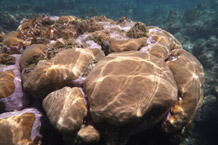
The relationship between coral and symbiotic algae is crucial to the survival of coral
Large-scale study reveals new insights into coral and symbiotic algae partnership
A large-scale study of Caribbean coral has yielded discoveries on the pairing process between an endangered coral and the microscopic symbiotic algae they rely on for survival.
In the largest study of its kind to date, a team led by the University of Exeter analysed 632 coral samples from 33 sites across the Caribbean and revealed that environmental factors drive this relationship, rather than host–symbiont genetics.
The research, published in the journal Proceedings of the Royal Society B, could have implications for work to protect and promote recovery in reefs. It examined the coral Orbicella annularis, a reef-building coral found throughout the Caribbean. The single celled alga – Symbiodinium – colonises tropical corals worldwide and provides nutrients that are key to the coral’s survival, through photosynthesis, which the coral on its own cannot perform. Unfortunately, the important relationship between Symbiodinium and coral can become disrupted by warming sea temperatures. Coral bleaching is triggered by a sustained increase in water temperature, which causes the algae to separate from their host coral and can often lead to the coral dying. In the Caribbean, 14 per cent of reefs have suffered severe coral death, with a further 46 per cent of reefs considered threatened. With coral playing the key role in many tropical marine ecosystems, the knock on effects of such damage on broader ecosystem health and marine biodiversity can be catastrophic.
Dr Jamie Stevens, of the University of Exeter, who oversaw the research, said: “The relationship between coral and symbiotic algae is crucial to the survival of coral, and the more we can understand about how and why it occurs, the better our chances of protecting and reinstating the reefs that are fundamental to a healthy marine ecosystem. This is the first time anyone has had enough data to explore this in detail. Unlike many other symbiotic relationships, we have found that this one is not predetermined by particular genotypes pairing up. Instead, it is dictated by geographical and environmental factors, meaning that the symbiodinium must already be present on the reef before it pairs with its host coral and thrives, to the benefit of both.”
There are hundreds of different species of Symbiodinium, and while many corals pair with one specific type, Orbicella annularis is interesting because it can team up with different types, and sometimes contains mixes of several species. Different types of Symbiodinium have different qualities, and this can determine how the coral behaves.
Dr Emma Kennedy, lead author of the paper, explained: “Genetically identical corals containing different algae mixes may grow differently or respond differently to stress, depending on the hardiness of the algae, how efficiently it photosynthesises, or how many nutrients it supplies to the host. Who you’re paired up with might well be the difference between life and death for a coral experiencing a mass bleaching event.”
The team found big regional differences in the relationships between the boulder star coral and its symbiotic algae – for example in the Bahamas the coral was almost always paired exclusively with a hardy and common Symbiodinium type, ‘B1’, while corals from the Lesser Antilles – Barbados, Tobago and Curacao – paired with other types. Corals from the Caymans were found to contain the most diverse pairings, with nearly all containing different Symbiodinium types.
The research was carried out in collaboration with the University of Queensland. It was funded by the Natural Environment Research Council (NERC), UK, and the European Union. It used DNA samples from both coral and algae across 33 sites in the Caribbean and The Bahamas, hand collected on SCUBA.
The paper, ‘Symbiodinium biogeography tracks environmental and geographic patterns rather than host genetics in a key Caribbean reef-builder, Orbicella annularis’, is published in the journal Proceedings of the Royal Society B, by Emma Kennedy, Linda Tonk, Nicola Foster, Iliana Chollett, Juan Ortiz, Sophie Dove, Ove Hoegh-Guldberg, Peter Mumby and Jamie Stevens.
Date: 4 November 2016
